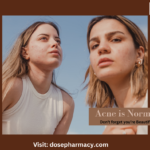Achieving radiant, healthy skin is a journey that begins with understanding your skin type and crafting a personalized skincare routine. With a plethora of products and techniques available, it can be overwhelming to navigate the world of skincare. However, by identifying your skin type and selecting suitable products Buy Isotretinoin Online and practices, you can build an effective skincare routine that nurtures and enhances your skin’s natural beauty.
Understanding Skin Types:
Before diving into skincare routines, it’s essential to recognize the various skin types and their characteristics:
Normal Skin:
Balanced and relatively low-maintenance, normal skin is neither too oily nor too dry. It has a smooth texture, minimal blemishes, and is generally resilient.
Oily Skin:
Oily skin is characterized by excess sebum production, leading to a shiny complexion, enlarged pores, and a tendency for acne and blackheads.
Dry Skin:
Dry skin lacks sufficient moisture, often feeling tight, flaky, or rough. It may be prone to fine lines, irritation, and dullness.
Combination Skin:
Combination skin features a mix of oily and dry areas, typically with an oily T-zone (forehead, nose, and chin) and drier cheeks.
Sensitive Skin:
Sensitive skin is prone to reactions such as redness, itching, and irritation, often triggered by environmental factors or certain skincare ingredients.
Crafting a Skincare Routine:
An effective skincare routine comprises several key steps tailored to your skin type’s specific needs. By following a consistent regimen and choosing appropriate products, you can optimize your skin’s health and appearance.
Cleansing:
Normal Skin:
Use a gentle, pH-balanced cleanser to remove impurities without stripping natural oils.
Oily Skin:
Opt for a foaming or gel-based cleanser with ingredients like salicylic acid to control excess oil and unclog pores.
Dry Skin:
Choose a hydrating, non-foaming cleanser that replenishes moisture and soothes dryness.
Combination Skin:
Use a mild cleanser targeted for combination skin, focusing on oily areas while hydrating drier areas.
Sensitive Skin:
Select a fragrance-free, hypoallergenic cleanser formulated for sensitive skin to minimize irritation.
Exfoliation:
Frequency:
Exfoliate 1-2 times per week to remove dead skin cells, unclog pores, and promote cell turnover.
Normal to Oily Skin:
Use a chemical exfoliant with ingredients like alpha hydroxy acids (AHAs) or beta hydroxy acids (BHAs) for gentle yet effective exfoliation.
Dry or Sensitive Skin:
Opt for a mild exfoliant with gentle granules or enzymes to avoid over-drying or irritating the skin.
Toning:
Purpose:
Toners help balance skin pH, remove residual impurities, and prepare the skin for better absorption of subsequent products.
Ingredients:
Look for alcohol-free toners containing hydrating ingredients like hyaluronic acid, glycerin, or soothing botanical extracts.
Treatment Serums:
Targeted Ingredients:
Choose serums with active ingredients tailored to your skin concerns, such as vitamin C for brightening, hyaluronic acid for hydration, or niacinamide for acne and inflammation.
Application:
Apply serums after cleansing and toning, gently pressing them into the skin for optimal absorption.
Moisturizing:
Hydration:
Use a moisturizer appropriate for your skin type to replenish moisture, strengthen the skin barrier, and prevent water loss.
Texture:
Opt for lighter, non-comedogenic moisturizers for oily or combination skin, and richer formulations for dry or mature skin.
Sun Protection:
Daily Use:
Apply a broad-spectrum sunscreen with SPF 30 or higher every morning, regardless of weather conditions, to shield the skin from UV damage.
Reapplication:
Reapply sunscreen every 2 hours, especially during prolonged sun exposure or outdoor activities.
Additional Considerations:
Eye Care:
Use an eye cream or gel to address specific concerns like dark circles, puffiness, or fine lines around the eyes.
Spot Treatment:
Incorporate spot treatments or acne treatments as needed for blemishes, breakouts, or other targeted concerns.
Weekly Treatments:
Consider adding weekly treatments such as masks, sheet masks, or overnight treatments to address specific skin needs like hydration, brightening, or pore refinement.
Adjusting Your Routine:
Skincare routines are not static and may require adjustments based on seasonal changes, hormonal fluctuations, lifestyle factors, or evolving skin concerns. Stay attuned to your skin’s feedback and modify your routine as needed to maintain optimal skin health.
Tips for Success:
Patch Test New Products:
Before fully incorporating new skincare products Buy Accutane Online into your routine, perform a patch test on a small area of skin to check for any adverse reactions or sensitivities.
Gradual Introduction:
Introduce new products one at a time and gradually to allow your skin to adjust and minimize the risk of irritation or breakouts.
Consistency is Key:
Stick to your skincare routine consistently to see optimal results. Skincare is a long-term commitment that requires patience and diligence.
Seek Professional Guidance:
Consult a dermatologist or skincare professional for personalized recommendations, especially if you have specific skin concerns or conditions that require professional evaluation and treatment.
In conclusion, building an effective skincare routine tailored to your skin type is a proactive step towards achieving healthy, radiant skin. By understanding your skin’s unique needs, selecting appropriate products, and following a consistent regimen, you can nurture your skin’s natural beauty and enhance its overall health and vitality.



